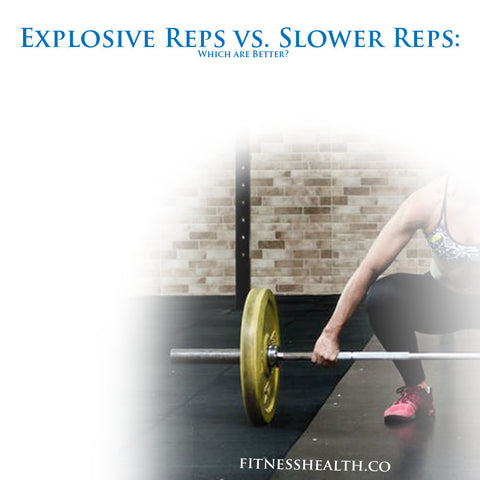
Almost all of the anaerobic exercises that you can perform including dumbbells, free weights, weight machines, and barbells have been mainly designed to build up the muscle mass of a person by making use of tension. But before you start weightlifting, you need to figure out whether you want to go for explosive reps or slower reps. Of course, neither of the two speeds are classified as wrong speeds; the two along with the tempo and the weights you lift only produces different results. However, before you decide whether to go for a slow rep or an explosive rep, you need to know the differences between the two.
What controls the speed of a rep?
The speed of every rep you do basically depends on the weight you lift, the number of repetitions that you perform, and how fatigued the muscle you are training is. Other outside factors can affect your rep speed. TuffWraps says that, by using wrist wraps or lifting straps, you might be able to do more reps, reducing muscle fatigue and allowing you to do more repetitions. However, they also recommend doing this in moderation so wrist wraps and lifting straps should not be used for every rep. Reps are done in a controlled and slow manner. About two seconds are used for the positive phase and around two seconds are used for the negative one as well. As the distance at which you lift the weight increases and as your muscle gets more fatigued, the time it takes to complete the positive phase increases and the time for the negative phase accelerates.
Understanding slow reps
A slow rep is defined as one which takes about ten seconds. When you are lifting a weight, it is referred to as the positive phase. When performing a slow rep, the positive phase should last for around four seconds. At the peak position, you should hold the weight for two seconds. This maximises the resistance. The same should be done when performing the negative phase i.e. bringing the weight back to the original position.
Slower rep, instead of placing stress on the biceps brachii, puts stress on the brachialis muscle. So, when you lift a weight slowly, the tension in the muscle is prolonged and as a result, the flow of blood through the muscle increases. Therefore, the purpose of slow reps is to build and grow the muscles.
What are explosive reps?
Explosive rep basically involves a fast tempo for lifting while you maintain a good form. Doing explosive reps minimises the tension that is experienced by the muscle, however, these reps allow you to lift heavier weights. While performing explosive reps, the positive phase should take even less than a second to complete. As a result, the fast twitch muscle fibres present in your body are more involved. These muscle fibres do not only produce the highest amount of force generated by any muscle but also possess the greatest capability for growing.
When you lift heavier weights, your overall strength and power increase. Explosive reps focus the load on the intended muscles. According to research, the training for explosive reps depends greatly on the major group of muscles that performs a particular exercise. Meanwhile, it focuses less on the aid of assistant muscles consequently increasing power.
Which one is suitable for you?
The truth is that there is no harm in performing reps at a slow pace or an explosive one. The bottom line is that you can benefit greatly from reps regardless of the tempo. The question remains; which one should you go for? Well, the answer to this depends on your goal. If you are aiming for an aesthetically pleasing and a muscular physique, then your choice should be the slow reps. On the other hand, if you want to increase the strength of your muscles, then you should focus on explosive reps. Just keep in mind that you need to give your muscles a bit of rest after a rep session regardless of the pace you choose.










1 comment
No mention of……
Explosive Lift and Slow Lowering as the inventor of CAM Machines (Nautilus) advocated.